Since the introduction of the vaping consumption tax on November 1st, nearly three weeks have passed, and the industry’s challenges are becoming more apparent. At a local vape shop, which has been in operation for years, the owner, let’s call him “Alex,” is feeling the pinch of what Huawei’s founder, Ren Zhengfei, described as a “chill.” The vape market, like many others, is experiencing its own kind of winter.

Alex shares his frustration, “Before, there were three vape shops within 100 meters of each other here, but now I’m the only one left standing.” He emphasizes that while the new vaping tax has had a significant impact on the industry, it’s not just the tax alone causing turmoil—it’s the overall shifts in regulations. The vaping industry, once in its early stages of explosive growth, is now facing growing pains as tighter rules take effect.
In fact, the changes in vaping regulations have brought a wave of fresh confusion. As of October 1st, the new vaping standards were enforced. These standards require that vape manufacturers and retailers hold a tobacco license and comply with other stringent rules. However, despite these regulations, certain corners of the market are still openly selling fruit-flavored vapes, circumventing these laws. It’s happening right under the noses of regulators, in the most unsuspecting of places.
The Vaping Underground: Hidden Flavors Still Flowing
On November 9th, a reporter ventured to multiple districts in a major city to investigate the underground vape market. Walking around a busy street in the city center, the reporter noticed a small vape shop. Despite the steady flow of pedestrians, the shop remained unusually quiet. Outside, delivery drivers were the only customers coming in and out, picking up vape cartridges by the handful.

Curious, the reporter entered the shop and asked about fruit-flavored vapes. The store owner immediately became defensive. “We only carry tobacco flavor,” they insisted. But when asked about the delivery drivers walking out with vape cartridges, the owner quickly changed the subject and refused to elaborate.
In another district, the story was strikingly similar. Delivery drivers were seen collecting vape products in bulk, while regular customers left empty-handed. The reporter, posing as a regular customer, was handed a WeChat QR code by the shop assistant after a quick inquiry about flavored vapes. “You can talk to my husband on WeChat. He handles all the orders,” the assistant said. Once contacted through the app, the reporter was able to arrange a purchase for a fruit-flavored vape cartridge, for the price of $13, plus an additional delivery fee.
The Vaping Black Market: A Web of Secrets
The hidden vape market isn’t just about fruit-flavored cartridges. In some corners of the internet, a whole new sub-market has emerged—one that focuses on rebranding and reselling non-compliant vaping products. A product that has been making waves online is the “milk tea cup” vape, a novelty product shaped like a cup of milk tea, which has become increasingly popular due to its massive size and fruity flavors. Some sellers boast that one of these milk tea cups can last up to 5,000 puffs, but the reality is that many of these products are being made outside the established, regulated supply chains, making their safety highly questionable.

In online forums, people are discussing the so-called “flavor sticks”—filter attachments that can transform the taste of a regular tobacco vape into fruity flavors like watermelon, strawberry, or even tropical blends. These flavor sticks are being marketed as a quick fix for those who want the vaping experience without breaking the law. A supplier named “Fruit Vape King” claimed to have a product that could fit nearly every major vape brand’s cartridges, allowing users to turn any regular vape into a fruity treat.
Vaping’s Legal Storm: The Industry Faces Growing Pains
For those on the inside, the vaping market seems to have split into two distinct worlds. The first world is the one that complies with the law—the established, licensed brands that meet the growing regulatory demands. These businesses, which have existed for several years, are adapting to the new vaping consumption tax and other regulatory changes. However, the second world operates in the shadows. This world is full of unlicensed operators who continue to profit from the lack of stringent enforcement in certain areas.
One former vape shop owner, who recently exited the industry, said, “A lot of people have been stocking up on flavored vapes—especially watermelon, strawberry, and mint flavors—since September. What used to cost $10 for a pack of two is now being sold for $20 a pack.” These price hikes reflect the growing demand for unregulated products that continue to flood the market.
This underground economy has led to the rapid rise of platforms like WeChat, which are being used as hubs to facilitate these hidden transactions. The growth of delivery services has only fueled this market, as people looking for fruit-flavored vapes can get them discreetly delivered to their doorsteps. Delivery drivers have become an essential link in this covert supply chain, with some taking on as many as 16 vape deliveries in a single day.
The Shift to a More Regulated Future: Will It End the Chaos?
It’s clear that the vaping industry is experiencing some major growing pains. With the new tax laws, stricter regulations, and ongoing crackdowns on illegal products, the market is seeing a seismic shift. In 2021, vaping was still a gray area, with few regulations in place. But now, governments are actively working to bring vapes under the same regulatory umbrella as traditional cigarettes, and the industry is being forced to adapt.
On the bright side, these new regulations offer an opportunity for the market to mature and grow in a healthier direction. The introduction of the vaping consumption tax, for example, signals that vapes are being treated like cigarettes and are subject to similar controls. This tax structure includes a 36% tax on production and an 11% tax on wholesale distribution, which should ultimately help streamline the market.
The ultimate goal is to move away from the chaos of unregulated, underground products and toward a safer, more transparent vaping industry. As Alex, the vape shop owner, puts it: “The market will go through some pain, but eventually, things will stabilize. People will get used to the new rules, and the shady side of the market will fade away.”
Looking Ahead: A More Stable Vaping Market?
For now, the vaping market in certain regions is stuck in a transitional phase, with many businesses either forced to comply with the new regulations or go underground. However, the long-term outlook is much brighter. As the market matures and regulation tightens, it’s expected that the vaping industry will become safer, more regulated, and ultimately more responsible.

The key takeaway here is that businesses need to embrace the changing rules. Those that can navigate the complex regulatory landscape will likely thrive, while those that continue to flout the laws will inevitably face legal consequences. In the end, vaping might not just be a passing trend—it could become a legitimate, regulated industry that aligns with public health goals and offers a safer alternative to traditional smoking.
As the market adjusts, consumers should be cautious and always consider the long-term implications of using unregulated products. Health concerns continue to loom large over the vaping industry, and until more is known, it’s important to make informed decisions about what goes into your lungs.
In Conclusion: The Future of Vaping Is Up in the Air
With stricter regulations on the horizon, the vaping market is on the brink of a major transformation. While the illegal side of the industry will likely continue to persist for a while, those willing to follow the law will eventually rise to the top. Just like with any major industry shift, it will take time for consumers and businesses to adjust. But with the right regulations in place, the vaping market can become safer, healthier, and more sustainable for everyone involved.


